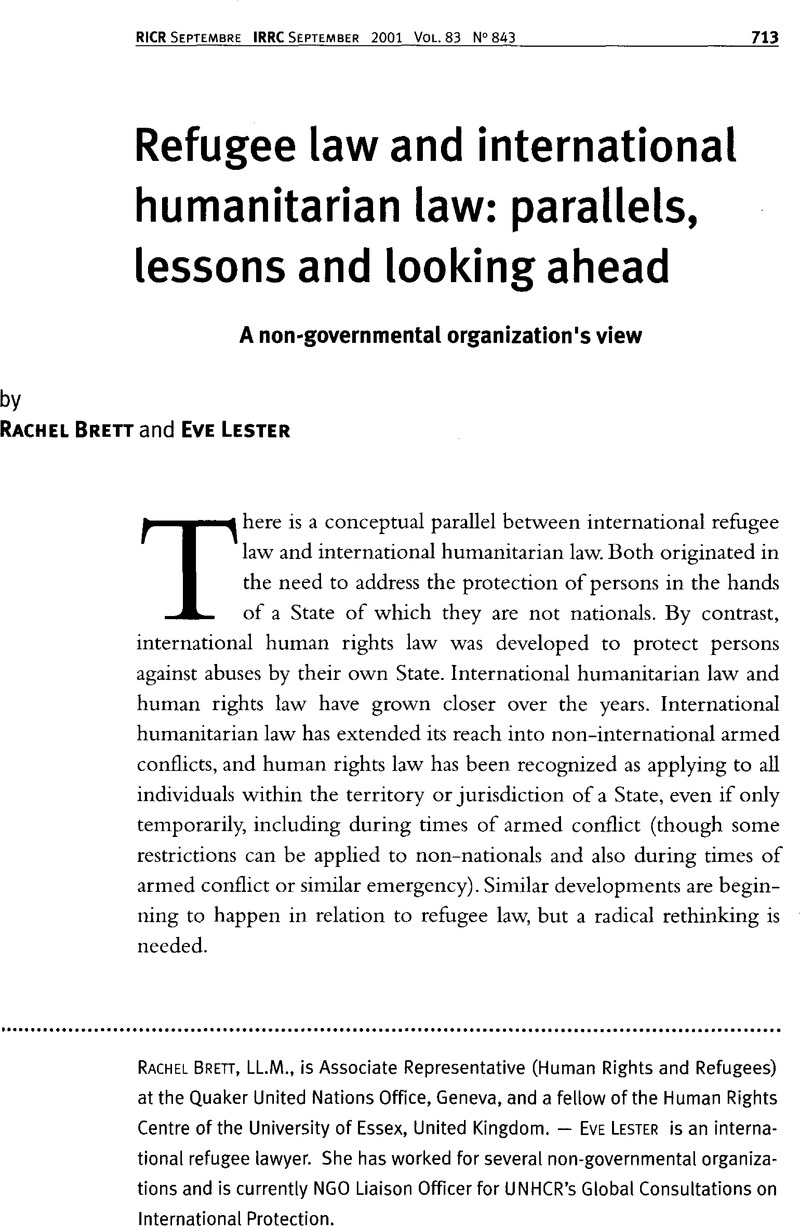Published online by Cambridge University Press: 19 April 2010

01 See for example the decisions of the UN Committee against Torture with regard to returning individuals to situations where they are likely to be tortured and the reports of the Working Group on Arbitrary Detention concerning detention of asylum-seekers.
02 (Fourth) Geneva Convention relative to the Protection of Civilian Persons in Time of War, Article 44, and Protocol Additional to the Geneva Conventions of 12 August 1949, and relating to the Protection of Victims of International Armed Conflicts (Protocol I), of 8 June 1977, Article 73.
03 UNHCR Global Consultations on International Protection, 8-9 March 2001, Geneva. Statement by the Lawyers Committee for Human Rights on behalf of NGOs, Agenda Item 20i): Civilian character of asylum, including separation of armed elements and screening in mass influx situations, as well as status and treatment of ex-comba-ants.
04 Ibid/. Emphasis added.
05 Ibid/.
06 The Hague Convention (V) respecting the Rights and Duties of Neutral Powers and Persons in Case of War on Land, of 1907, governs relations in the event of international armed conflict. Its provisions are deemed to have attained the status of customary law, and it is considered by the ICRC to apply by analogy to situations of internal armed conflict.
07 UNHCR Global Consultations on International Protection, 8-9 March 2001, Geneva. Statement by the ICRC on “The civilian character of asylum: Separating armed elements from refugees”.
08 This approach is reflected in the Summary Conclusions from the UNHCR Expert Roundtable on Exclusion and Cessation, Lisbon, 3-4 May 2001. See paras (4) and (14).«http://www.unhcr.ch/issues/asylum/ globalconsult/main.htm».
09 This was acknowledged in the UNHCR Regional Symposium on Maintaining the Civilian and Humanitarian Character of Asylum/Refugee Status, Camps and other Locations, Pretoria, South Africa, 26-27 February 2001, which was held as part of the UNHCR's Global Consultations on International Protection. See e.g. Key Conclusions and Recommendations, para. 2(c).
10 See e.g. A. V. Australia/, Communication No. 560/1993: Australia. 30/04/97. CCPR/ C/59/D/560/1993. See also: “The scope and content of the principle of non refoulement”, Opinion of Sir Elihu Lauterpacht CBE QC, and Daniel Bethlehem, Barrister, of 20 June 2001. Paper prepared for a forthcoming UNHCR Expert Roundtable on Articles 33 and 35 of the 1951 Convention, which draws heavily on international human rights law in clarifying the scope and content of international refugee law, in particular the principle of non-refoulement. See http://www.unhcr.ch/ issues/asylum/globalconsult/nr_opinion.pdf.
11 As part of UNHCR's Global Consultations on International Protection an Expert Roundtable is to be held in Geneva in November 2001 to examine the scope of Article 31 of the 1951 Convention.
12 UNHCR's Guidelines on applicable Criteria and Standards relating to the Detention of Asylum-Seekers, Geneva, 10 February 1999, Guideline 1. See http:// www.unhcr.ch/issues/asylum/guidasyl.htm.
13 ibid.
14 The Human Rights Committee is preparing a new General Comment on Derogations which considers, inter alia, the implications of the requirement that States Parties, when derogating from their obligations under the International Covenant on Civil and Political Rights, must not do so in a way that is incompatible with their other obligations under international law, and the role of the Committee in supervising this. - On this question see also Louise Doswald-Beck and Sylvain Vite, “International humanitarian law and human rights law”, IRRC, No. 293, March-April 1993, pp. 94-119.
15 See also Additional Protocol I, Article 11.
16 Human Rights Watch Press Release, 15 December 1999.
17 For non-international armed conflict, see Art. 3 common to the 1949 Geneva Conventions and Art. 5 of the Protocol Additional to the Geneva Conventions of 12 August 1949, and relating to the Protection of Victims of Non-International Armed Conflicts (Protocol II), 8 June 1977.
18 See e.g. Walter Kälin, “Supervising the 1951 Convention on the Status of Refugees: Article 35 and beyond”, prepared for the Cambridge Expert Roundtable (9-10 July 2001).
19 See Lauterpacht and Bethlehem, op. cit. (note 10).